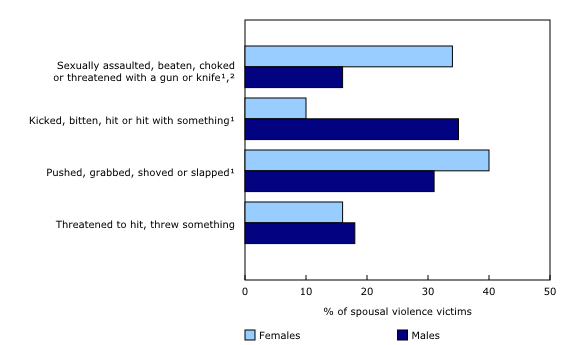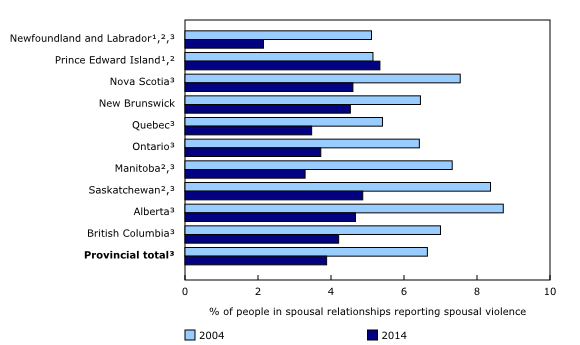Family violence in Canada: A statistical profile, 2014
Archived Content
Information identified as archived is provided for reference, research or recordkeeping purposes. It is not subject to the Government of Canada Web Standards and has not been altered or updated since it was archived. Please "contact us" to request a format other than those available.
Released: 2016-01-21
Trends in self-reported spousal violence
Self-reported spousal violence decreases in the provinces
Results from the 2014 General Social Survey (GSS) on victimization show that of the 19.2 million Canadians in the provinces who had a current or former spouse or common law partner, about 4% (760,000 individuals) reported having been physically and/or sexually abused by their partner during the preceding five years. This was significantly fewer than what was reported a decade earlier in 2004 (7%).
Slightly more men (4.2%) than women (3.5%) with current or former spouses or partners reported being victims of spousal violence. Both sexes experienced similar declines in spousal violence since 2004.
Almost half (49%) of spousal violence victims reported that they had been abused one time during the previous five years while just over one-third (35%) reported 2 to 10 violent episodes. About 2 in 10 victims of spousal violence reported that they had been victimized on more than 10 occasions. These proportions were similar among male and female victims. Of note, 70% of self-reported spousal violence did not come to the attention of the police.
Many victims report spousal violence occurring after a breakup
Many of those victimized by a former partner indicated that they had suffered violence after their relationship had ended (41%). Almost half (49%) of spousal violence victims who had reported that violence occurred after their relationship ended stated that the severity of the abuse increased after the break up. Men and women were equally likely to report that this escalation of severity followed the end of their relationships.
Spousal violence was more frequently reported as having occurred in relationships that ended (13%) than among individuals currently in a marriage or common-law relationship (2%). Most victims that reported having been abused by a former partner indicated that the violence had taken place while they were still living together (78%).
Most severe forms of spousal violence reported more often by female victims
According to the 2014 GSS, one-quarter of spousal violence victims reported having been sexually assaulted, beaten, choked, or threatened with a gun or a knife. Women (34%) were twice as likely to report having experienced this most severe form of violence than men (16%). Just under one-quarter of victims (24%) reported having been kicked, bitten, hit, or hit with something. Men (35%) were over three times more likely to report this type of spousal violence than women (10%).
Spousal sexual assault was reported by 7% of victims. Among them, over half (59%) reported non-consensual sexual activity that was a result of being manipulated, drugged or otherwise coerced, sometimes in combination with sexual assault through physical force.
Spousal violence victims report effects consistent with post traumatic stress disorder
Just under one-third (31%) of spousal violence victims reported sustaining physical injuries such as bruises, cuts or broken bones as a result of spousal violence, with women (40%) more likely than men (24%) to report such injuries in the previous five years. Overall, these proportions have remained steady over the past decade.
In addition to physical injuries, psychological effects consistent with post traumatic stress disorder (PTSD) were reported by spousal violence victims in the provinces. About 16% of victims reported three or more of the long-term effects outlined in the Primary Care PTSD Screen, including nightmares, avoidance of situations that bring the incident(s) to mind, feeling constantly on guard, and feeling detached from others. According to the GSS, female spousal violence victims were more likely to report these effects than male victims. Effects consistent with PTSD were more prevalent among those victims who experienced multiple victimizations (36% of those who were victimized more than 10 times), and those that reported the most severe types of violence (32%).
Experiences of childhood maltreatment reported by almost half of spousal violence victims
Findings from the 2014 GSS indicate there may be a relationship between abuse during childhood and spousal violence later in life. More individuals who reported experiencing spousal violence reported having been physically and/or sexually abused as a child (48%), compared with those who did not report experiencing spousal violence (32%). Male and female victims of spousal violence reported similar rates of childhood victimization.
A history of family violence in their childhood home was notable among those who reported being the victim of spousal violence. Over one in five (21%) people who experienced spousal violence in the previous five years reported having witnessed abuse committed by a parent, step-parent or guardian as a child, compared with 11% of those in relationships free of violence.
Spousal violence more prevalent among Aboriginal people, especially women
According to the GSS, Aboriginal people (9%) were more than twice as likely as non-Aboriginal people (4%) to report experiencing spousal violence in the previous five years. In particular, Aboriginal women (10%) were more likely to be victimized by current or former partners, compared with non-Aboriginal women (3%).
Aboriginal people more often reported having experienced abuse as children, a factor that may be associated with spousal victimization later in life. In 2014, 40% of those who identified as an Aboriginal person indicated that they had been either sexually abused, physically abused, or both sexually and physically abused as children, compared with 29% of non-Aboriginal persons.
Rates of spousal violence virtually unchanged for Aboriginal people
While rates of self-reported spousal victimization among the non-Aboriginal population decreased between 2009 (6%) and 2014 (4%), rates for Aboriginal people were virtually unchanged from 2009 (10%) to 2014 (9%).
Most provinces report significant 10-year declines in self-reported spousal violence
Across the provinces, rates of self-reported spousal violence measured by the 2014 GSS were generally similar to the overall Canadian provincial rate (4%). Since 2004, most provinces have recorded significant declines in self-reported spousal violence. The largest declines were in Alberta, Manitoba, Saskatchewan and British Columbia.
Police-reported family violence
One-quarter of the victims of police-reported violent crimes are victimized by a family member
While the GSS collects information on spousal violence whether or not it comes to the attention of police, a secondary source of information is police-reported data. Of the more than 323,600 victims of police-reported violent crime in Canada in 2014, 26% were victimized by a family member. The majority of police-reported family violence victims (68%) were women and girls.
Nearly half (48%) of all victims of police-reported family violence were victimized by either a current or former spouse, while a parent was the perpetrator for nearly 18% and an extended family member such as an uncle, an aunt, a cousin or a grandparent was the perpetrator for nearly 14% of the victims.
In 2014, 53,647 victims of police-reported violent crime were below the age of 18. Children under 12 years of age were most commonly victimized by a parent (38%) or an acquaintance (35%), and rarely by a stranger (10%). Senior victims of family violence (65 years and older) were most commonly victimized by a grown child (33%).
Regardless of age, sex or relationship of the accused to the victim, physical assault was the most common form of family violence, experienced by nearly three-quarters of victims (73%). Sexual offences were experienced by 8% of victims of family violence. Overall, rates of both family-related physical and sexual assault declined 3% from 2013. Youth aged 12 to 17 years were at the highest risk of family and non-family related sexual offences, (369.5 per 100,000 youth), which include sexual assaults.
Rate of police-reported family violence highest in the territories
Similar to 2013, rates of police-reported family violence were highest in the territories, while among the provinces, the highest rates of family violence were in Saskatchewan (486.7 per 100,000 population) and Manitoba (358.4) and the lowest were in Ontario (154.8) and Prince Edward Island (157.1).
Saguenay (342.8) and Gatineau (327.2) had the highest rates of police-reported family violence among Canada's census metropolitan areas, while Ottawa (93.9) and St. Catharines–Niagara (110.5) had the lowest.
An infographic illustrating selected data on "Family Violence in Canada" is also available.
Note to readers
The report "Family violence in Canada: A statistical profile" was produced by the Canadian Centre for Justice Statistics at Statistics Canada under the Federal Family Violence Initiative. It provides the most current data on the nature and extent of family violence in Canada, as well as trends over time, as part of the ongoing initiative to inform policy makers and the public about family violence issues.
This year, updated information for the provinces is available on self-reported incidents of spousal violence based on data from the 2014 General Social Survey (GSS) on victimization. The GSS is a household survey conducted every five years; the most recent cycle was conducted in 2014. The target population of the survey is composed of people aged 15 and older in the provinces. In 2014, 33,127 respondents took part in the survey. The GSS on victimization was also conducted in the territories, and the results of that survey will be released at a later date.
The report "Family violence in Canada: A statistical profile" also presents information on incidents of family-related violence that were brought to the attention of the police. Police-reported data for the provinces and territories are gathered by the Uniform Crime Reporting Survey (UCR) and the Homicide Survey. The UCR Survey is an annual census of all violations of the Criminal Code and certain other federal laws that come to the attention of the police and that the police have substantiated, while the Homicide Survey collects information on all culpable homicides in Canada.
Although these three surveys—the GSS, UCR and Homicide Survey—cover similar themes, they have numerous differences in terms of survey type, scope, coverage and data sources. As a result of these differences, these surveys provide robust and complementary information on family violence in Canada.
Correction note
On December 7, 2021, findings that indicated equal prevalence of males and females who experienced violence committed by a current or former spouse or common-law partner were corrected to reflect that they were in fact different to a statistically significant degree: males = 4.2% and females = 3.5%.
Products
The Juristat article "Family violence in Canada: A statistical profile" (85-002-X) is now available. From the Browse by key resource module of our website under Publications, choose All subjects, then Crime and justice and Juristat.
The infographic "Family Violence in Canada," which is part of Statistics Canada - Infographics (11-627-M), is also now available.
Contact information
For more information, or to enquire about the concepts, methods or data quality of this release, contact us (toll-free 1-800-263-1136; 514-283-8300; STATCAN.infostats-infostats.STATCAN@canada.ca) or Media Relations (613-951-4636; STATCAN.mediahotline-ligneinfomedias.STATCAN@canada.ca).
- Date modified:



